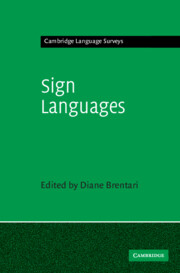Book contents
- Frontmatter
- Contents
- List of figures
- List of tables
- List of contributors
- List of sign language abbreviations
- Notational conventions
- 1 Introduction
- I HISTORY AND TRANSMISSION
- II SHARED CROSSLINGUISTIC CHARACTERISTICS
- 8 Notation systems
- 9 Verb agreement in sign language morphology
- 10 Functional markers in sign languages
- 11 Clause structure
- 12 Factors that form classifier signs
- 13 Handshape contrasts in sign language phonology
- 14 Syllable structure in sign language phonology
- 15 Grammaticalization in sign languages
- 16 The semantics–phonology interface
- 17 Nonmanuals: their grammatical and prosodic roles
- III VARIATION AND CHANGE
- Notes
- References
- Index
15 - Grammaticalization in sign languages
from II - SHARED CROSSLINGUISTIC CHARACTERISTICS
Published online by Cambridge University Press: 05 June 2012
- Frontmatter
- Contents
- List of figures
- List of tables
- List of contributors
- List of sign language abbreviations
- Notational conventions
- 1 Introduction
- I HISTORY AND TRANSMISSION
- II SHARED CROSSLINGUISTIC CHARACTERISTICS
- 8 Notation systems
- 9 Verb agreement in sign language morphology
- 10 Functional markers in sign languages
- 11 Clause structure
- 12 Factors that form classifier signs
- 13 Handshape contrasts in sign language phonology
- 14 Syllable structure in sign language phonology
- 15 Grammaticalization in sign languages
- 16 The semantics–phonology interface
- 17 Nonmanuals: their grammatical and prosodic roles
- III VARIATION AND CHANGE
- Notes
- References
- Index
Summary
Background: routes from gesture to language
In this chapter we examine the developmental routes by which gesture is codified into a linguistic system in the context of the natural signed languages of the deaf. We suggest that gestures follow two routes as they codify, and thus that signed languages provide evidence of how material which begins its developmental life external to the conventional linguistic system, as spontaneous or conventional gestures, is codified as language.
The first route begins with a gesture that is not a conventional unit in the linguistic system; these gestures enter signed languages as lexical signs and develop further to grammatical morphemes (Figure 15.1). Previously, linguists working with spoken language data have described grammaticalization, the process by which grammatical morphemes develop out of lexical morphemes (Heine, Claudi & Hünnemeyer1991b, Hopper & Traugott 1993, Bybee, Perkins & Pagliuca 1994). We claim that the first route is as an extension of the typical grammaticalization process “backwards” in developmental time beyond the linguistic system. It identifies the gestural source of a lexical morpheme. We also claim that codification, which drives grammaticalization in spoken and signed languages (Haiman 1998, Janzen 1999), also drives the development of gesture into language (see also Janzen & Shaffer 2002, Wilcox 2007).
The second route proceeds along quite a different path. In this route, the source gesture is one of several types including the manner of movement of a manual gesture or sign, and various facial, mouth and eye gestures.
- Type
- Chapter
- Information
- Sign Languages , pp. 332 - 354Publisher: Cambridge University PressPrint publication year: 2010
- 21
- Cited by

